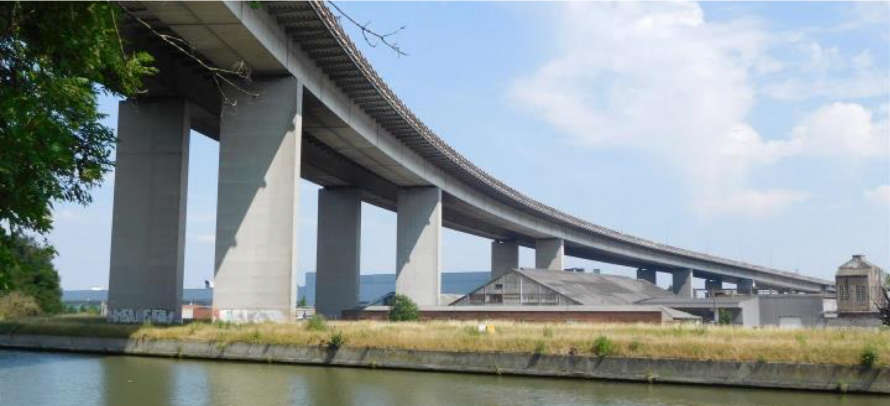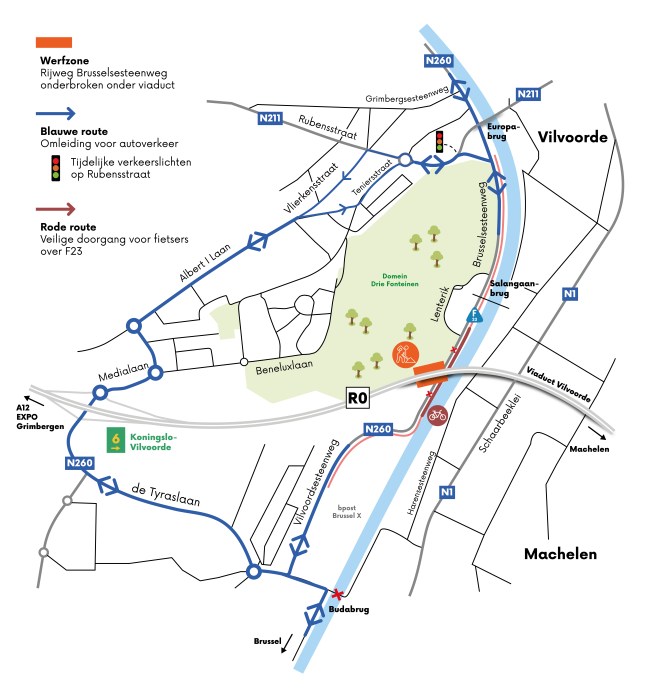Viaduct Vilvoorde
The Vilvoorde viaduct is probably one of the best known parts of the Brussels Ring Road. The bridge has a length of 1,700 metres, is more than 30 metres high and rests on 22 rows of piers.
There is currently no safety problem, but the immense structure is in urgent need of renovation today. Over the next few years, we will renew the viaduct so that we can also guarantee future safety, make the bridge suitable for exceptional transport and possibly open a fourth lane in the future.
Current construction works
On the side of Drie Fonteinen park, a scaffolding structure some 400m long is currently being fixed under the Viaduct. As many as 200 000 (!) parts are needed for the construction. This scaffold serves as a working platform to remove asbestos-containing paint, reinforce the steel structure and apply a protective coating.
The scaffolding is currently being built under the R0 inner ring on the west side of the Viaduct (Koningslo side) and is gradually moving towards the east side of the Viaduct (Machelen side). After the inner ring, the platform will move to the outer ring.
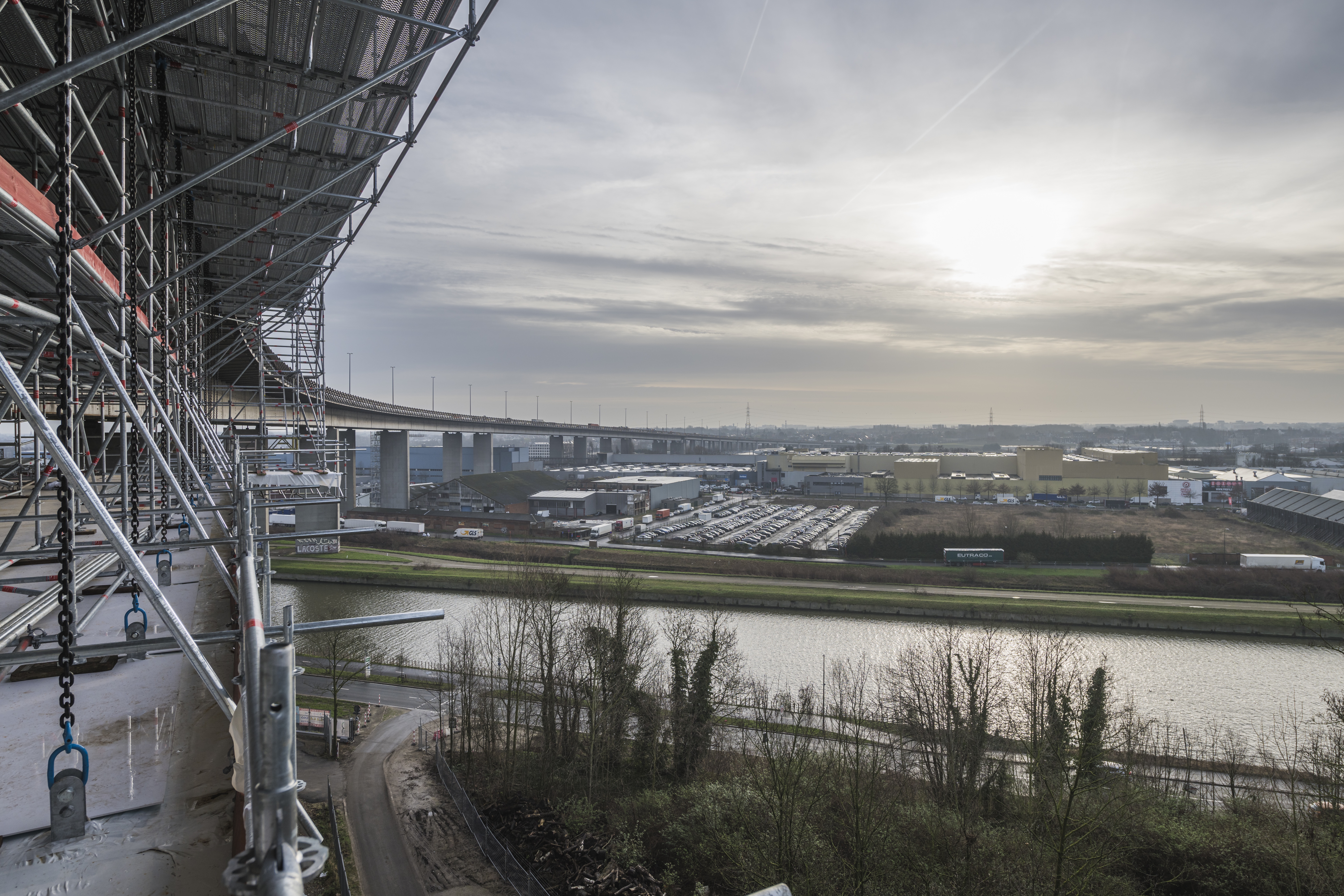
Disruption on Brussels Ring Road
The large-scale renovation on the Vilvoorde Viaduct has started. From 16 August, there will be disruption to traffic. There will be three narrowed lanes on the inner ring road. Nothing will change on the outer ring road in the first phase. The works will take around eight years in total. For a full look at the phasing and disruption, click here:
Phasing & disruption
After nearly 50 years of intensive use, major maintenance is needed
Just like a car or a house, bridges and roads also need maintenance. Especially when that infrastructure is very much in use. As early as 1978, the first cars drove over the Vilvoorde viaduct. Meanwhile, some 150,000 vehicles cross the bridge every day. And that causes quite a lot of wear and tear, more than engineers could have predicted in the 1970s. A large-scale renovation looking to the future is therefore necessary. Key points of focus:
- Safety comes first! Based on measurements, we closely monitor the condition of the viaduct. Currently, there is no safety risk. But we are looking beyond today and want to address the wear and tear on the viaduct now. That way we will avoid problems on or under the viaduct later.
- Strengthening takes heavy exceptional traffic out of residential areas We reinforce the viaduct so that heavy exceptional traffic can also use the bridge. That traffic will then no longer drive through the surrounding residential areas around the viaduct.
- Ready for a fourth lane if necessary By reinforcing the viaduct, the bridge can also carry more vehicles. If there is a need for a fourth lane later on, we can open it.
- Remediation of old paint layers containing asbestos Like many structures of the past, the viaduct also contains asbestos. That asbestos is in the paint that protects the steel structure. There is currently no risk of spreading because the asbestos is well encapsulated in the paint layers. Along with the renovation, we will also remove that asbestos immediately.
- Improving comfort We will replace the old asphalt with a new layer. We will also renew the crash barriers and install energy-efficient lighting.
How do we tackle renovation?
An enormous challenge
Renovating one of the longest bridges in Flanders at a height of more than 30 metres is a large and complex job. Moreover, the viaduct consists of two bridges of 1,700 metres each right next to each other. We are therefore talking about a total of 3,400 metres of motorway!
We are renovating the following parts of the viaduct: the asphalt, the steel supporting structure on which the concrete slab rests, the asbestos-containing paint on the steel supporting structure, the crash barriers and the lighting. We are also laying a new concrete slab under the asphalt.
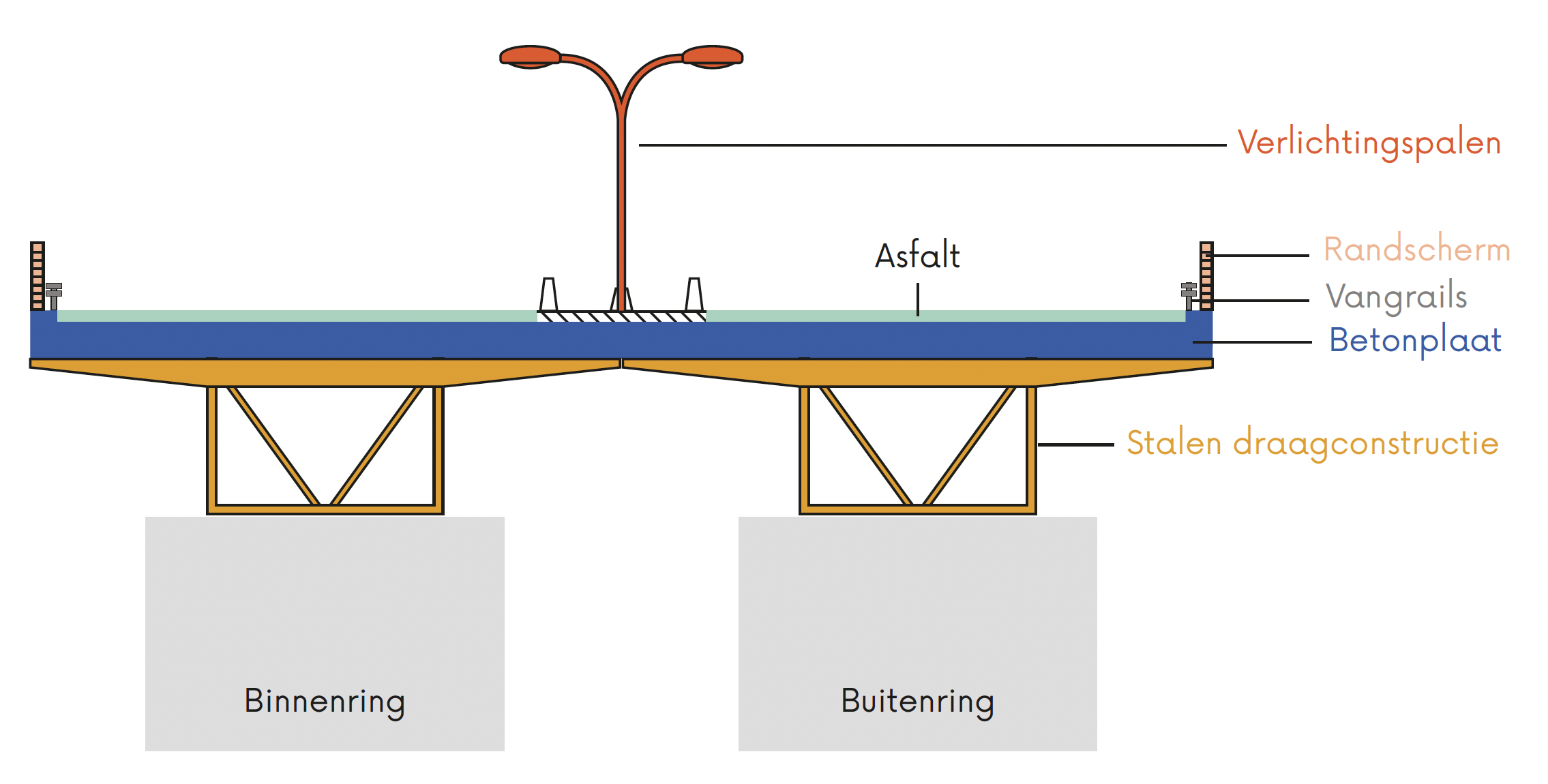
Starting point: traffic should continue to drive over the viaduct as much as possible
Not only are the works complex, the viaduct is also a very important traffic artery for both national and international traffic. Completely closing the viaduct would help the contractor to work faster, but this is impossible. The negative impact on traffic and the economy would be too severe.
Approach: alternating work on inner and outer ring road
To allow cars and trucks to cross the viaduct as much as possible, we decided together with the contractor to tackle the works in several phases. During each phase, a different part of the viaduct will become work zone and thus closed to all traffic. In the meantime, traffic can continue to drive on (narrowed) lanes on the other section. To ensure safety for road users and the contractor, we reduce speed during the works.
By the way, the contractor is not only working on the viaduct, but also in an enclosed scaffolding suspended under the viaduct.
Disruption on and below the viaduct
-
Several phases to minimise disruption
The works on, in and under the viaduct are complex. The contractor faces a difficult task in which he always puts the safety of his workers and road users first. In addition, he must allow traffic on the Viaduct to flow as much as possible in both directions. To minimise disruption, we are therefore working in several phases. Below you can read more about the different phases and the expected disruption on and under the Viaduct.
Please note: this phasing may change due to unforeseen circumstances such as the weather.
-
Disruption on the viaduct
Phase 1: August 2023 - end of 2025
Traffic towards Ghent (outer Ring road)
- no disruption
Traffic direction Zaventem (inner Ring road)
- 3 narrowed lanes with speed reduction
- during some weeknights 1 narrowed lane with reduced speed
- no traffic possible over 3,5 tonnes during all weekends (from the summer of 2024 until the end of 2025)
Detours can be made via the regional diversions. More information on the detour tab.
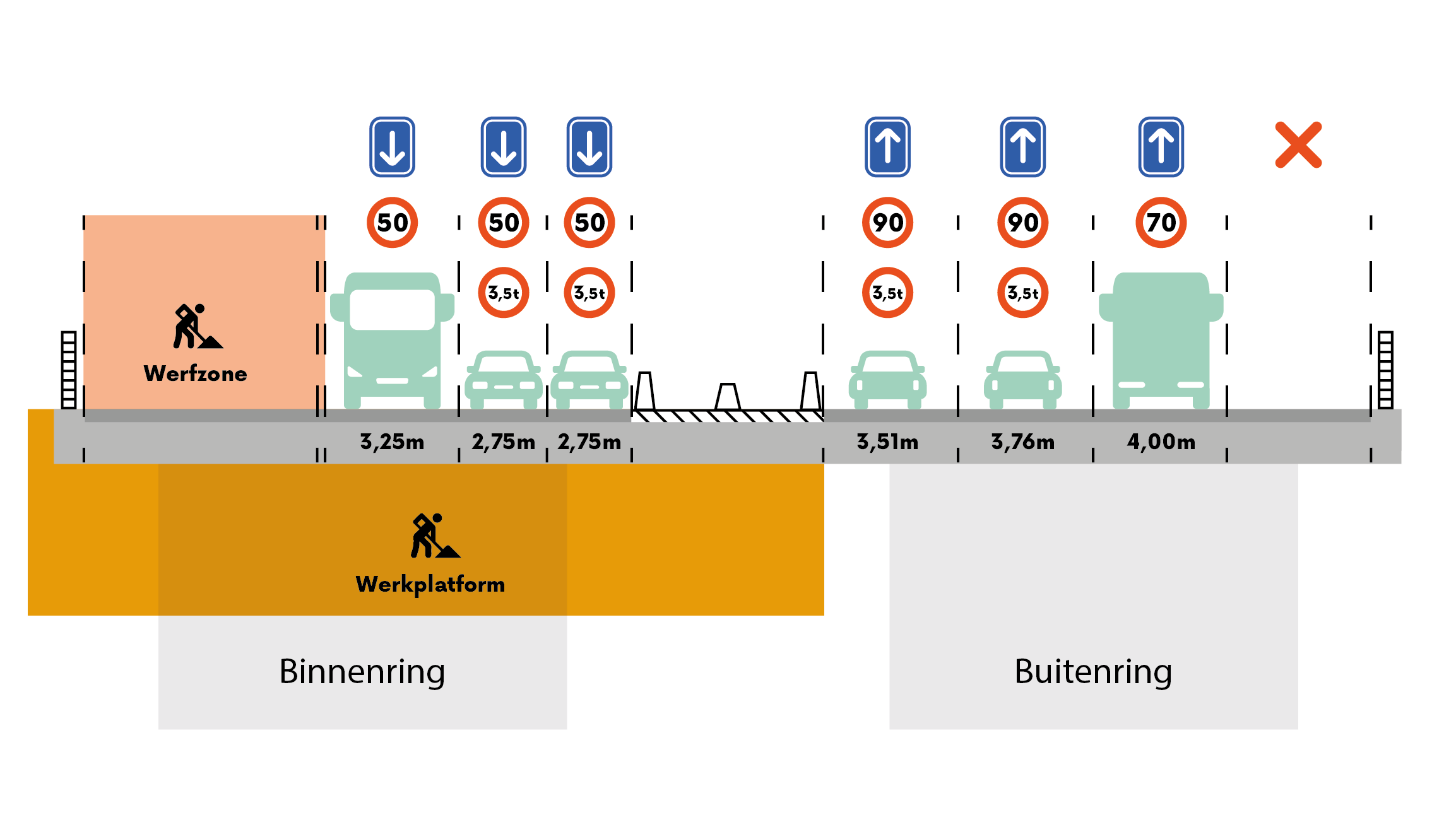
Phase 2: Spring 2026 - Spring 2027
Traffic direction Ghent (outer Ring road)
- 3 narrowed lanes with speed reduction
- 2 narrowed lanes with speed reduction on nights or at weekends
Traffic direction Zaventem (inner Ring road)
- 3 narrowed lanes with speed reduction
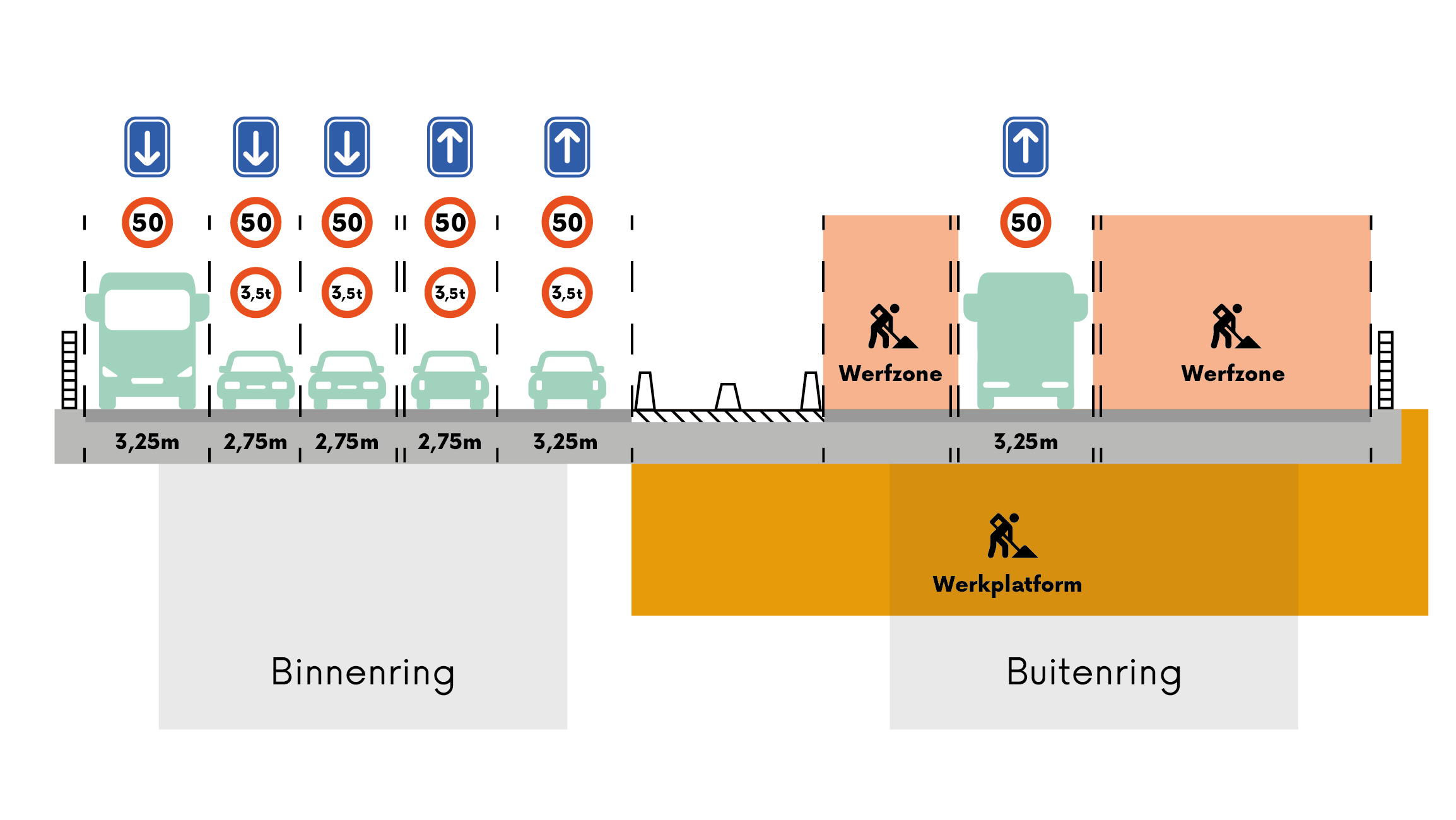 Phase 3: spring 2027 - end 2028
Phase 3: spring 2027 - end 2028Traffic direction Ghent (outer Ring road)
- 2 or 3 narrowed lanes with speed reduction
Traffic direction Zaventem (inner Ring road)
- 2 or 3 narrowed lanes with speed reduction
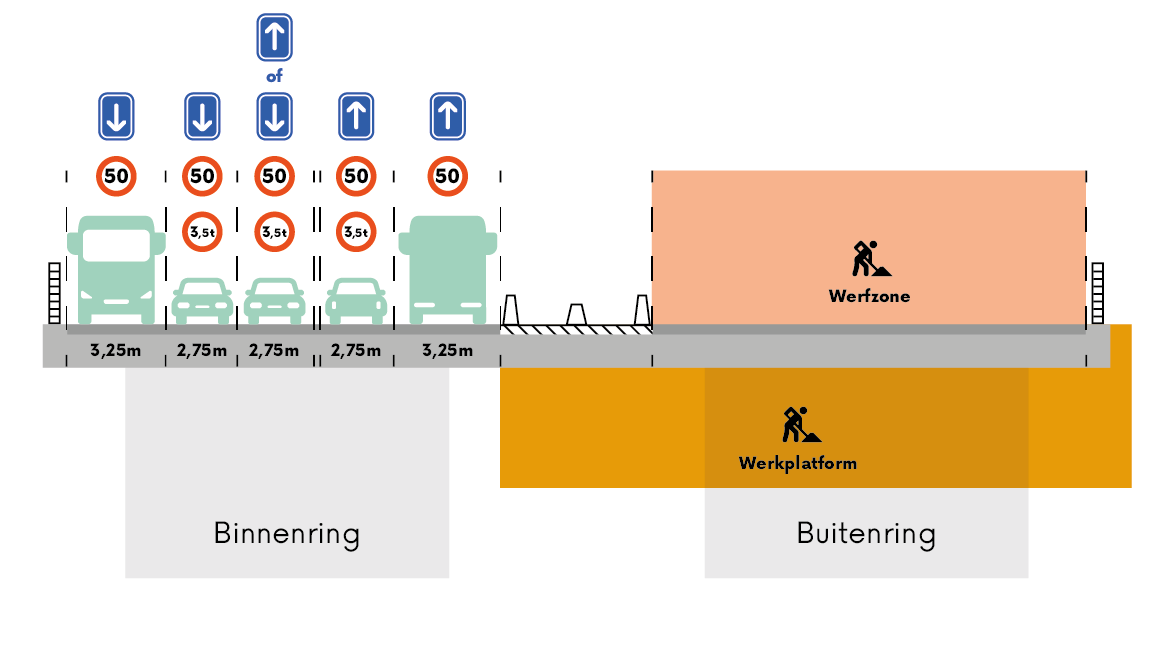
Phase 4: spring 2029 - end 2030
Traffic direction Ghent (outer Ring road)
- 2 or 3 narrowed lanes with speed reduction
Traffic direction Zaventem (inner Ring road)
- 2 or 3 narrowed lanes with speed reduction
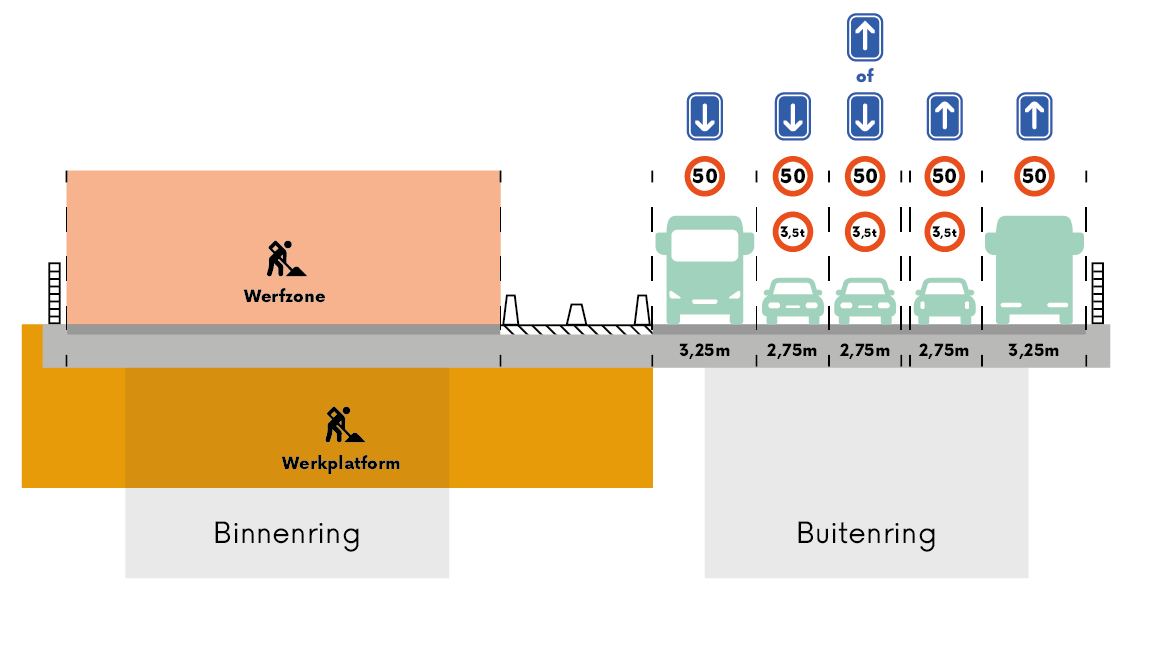
Phase 5: spring 2031 - summer 2031
Completion of works without disruption to traffic.
-
Disruption below the viaduct
From March 2024
In order to work on the underside of the Viaduct, the contractor will use a scaffold suspended under the Viaduct. The scaffolding will first be built on the west side of the Viaduct (Three Fountains domain) and will move towards the east side of the Viaduct (Zaventem side) after a few months each time. This is done first under the inner ring and then again under the outer ring.
Constructing and dismantling this scaffolding at a height of more than 30 metres is a complex and risky job. To ensure the safety of traffic and passers-by on the streets under the scaffolding, we will temporarily close local roads under the Viaduct during construction and demolition. It concerns: Brusselsesteenweg, Jaagpad Vaartdijk, Harensesteenweg and Schaarbeeklei.
The temporary closure of the Brusselsesteenweg is scheduled for several weeks from the end of March 2024. Further planning is yet to be worked out in detail. Keep an eye on our website and Facebook page and subscribe to our newsletter (Vilvoorde area). We also always bus residents' letters before we close a street.

Brusselsesteenweg onderbroken
Uit veiligheidsoverwegingen mag vracht- en autoverkeer vanaf maandagochtend 25 maart niet onder het viaduct doorrijden. De Brusselsesteenweg (N260) is tot uiterlijk eind april volledig onderbroken. Over de F23 blijft fietsverkeer wel mogelijk! Met een tijdelijke tunnel uit stalen containers zorgen we voor een veilige doorgang. Voor vracht en autoverkeer wordt een omleiding voorzien:
- Vrachtverkeer dat via de N260 naast het kanaal van de bedrijvenzones Westvaartdijk en Cargovil naar Brussel rijdt of omgekeerd moet omrijden via de R22 Woluwelaan, Luchthavenlaan, E19 en R0. Via complex 6 ‘Vilvoorde-Koningslo’ is er terug aansluiting op de N260.
- Autoverkeer op de Brusselsesteenweg moet onderaan de Europabrug de oprit naar de Rubensstraat nemen. Via tijdelijke verkeerslichten kan je hier linksaf richting Grimbergen: via Vlierkensstraat, Albert I laan en Medialaan rij je naar de N260 aan de zuidzijde van het viaduct.
During works on the Viaduct, traffic will often travel on narrowed lanes at a reduced speed. Traffic models indicate additional travel time on and around the Viaduct. We recommend avoiding the area if possible or using public transport or cycling. Within the Werken aan de Ring programme, we are deliberately investing in better cycling infrastructure and comfortable public transport at an accelerated pace.
From the summer of 2024 (still to be determined) until the end of 2025, vehicules over 3,5 tonnes will not be able to access the Viaduct in the direction of Zaventem during weekends.
The route advice below shows possible alternative routes.



